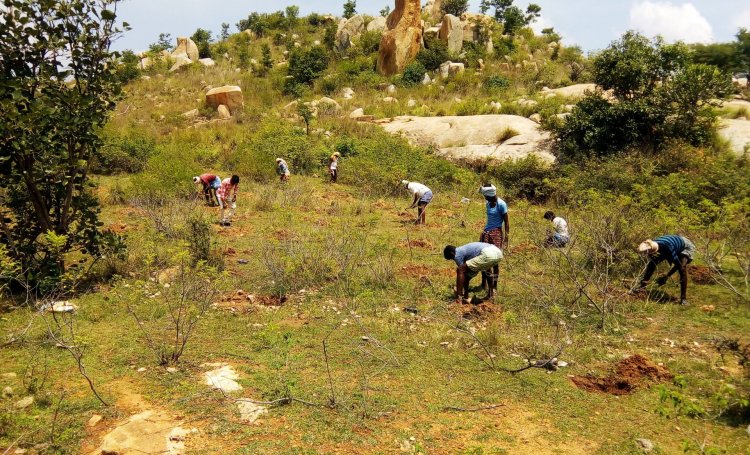
Plantation in Gomala (Image: Foundation for Ecological Security)
Common pool resources, popularly known as “commons”, are those resources which are accessible to the whole community or village and to which no individual has exclusive ownership or property rights. Commons have two essential characteristics: non-excludability and high-subtractability. Non-excludability means that it is impossible or very costly to restrict a user from using the resource, and subtractability or “rivalness” means that use of the resource by one user will diminish benefits for other users. In the context of India, commons include community forests, common grazing grounds, tanks and tank beds, foreshores, threshing grounds, rivers and riverbeds, where well-defined property regime may not exist.
Around 26 percent of India’s land mass (180 million hectares) can be classified as commons (Chopra and Gulati, 2001). In addition to meeting livelihood needs of rural population ($5 Billion annually, Beck and Nesmith, 2001), these resource systems serve critical ecological functions and services by contributing to carbon sequestration, biodiversity conservation, hydrological supplies and act as buffer zones or corridors to biodiversity rich areas. In spite of these vital services, commons have faced neglect due to unfavourable usage rights and weak institutional arrangements for local management and governance leading to widespread degradation.
In September 2019, the Government of India pledged to restore 5 million hectares of degraded land by 2030. The Forest Rights Act and several other policy initiatives such as the Mahatma Gandhi National Rural Employment Guarantee Act (MGNREGA) provide the much needed investment for securing the commons. Groundwater is a rapidly depleting common-pool resource and is interconnected with land and forests for sustainability. It is recognized as commons in the newer water policies but seldom managed using its principles.
On December 25, 2019, Prime Minister Narendra Modi launched the long-awaited Atal Bhujal Yojana (ABhY, Atal Jal). The Panchayat-led programme’s design incorporates principles of participatory groundwater management and behavioural change with primary focus on demand side management in seven states of India. Success of the program would depend largely on its ability to create mechanisms for managing groundwater as a common pool resource.
Challenges in managing commons
As widely studied and acknowledged in the past, commons are facing overconsumption and under-investment leading to depletion. This often results from individuals trying to maximize their own gains rather than work towards collective outcomes, which is referred to as tragedy of commons. Forests are being wiped out for development of infrastructure and industries, catchments feeding into water bodies are degraded, tanks and riverbeds are encroached for agricultural and real-estate purposes, and groundwater overexploitation has resulted in loss of livelihoods and even life in some cases.
India’s poor, whose reliance on commons to meet basic life requirements is high, are now forced to migrate under distress. Agriculture, which supports food security and livelihoods of majority of rural population, is under stress as farmers are finding it difficult to meet irrigation needs to protect their crops in drought situations.
The main challenge with managing commons stems from the existence of multiple uses and users that compete for the resource. Because of shared rights of usage, unrestricted access and unregulated use, the accountability for maintaining commons is largely not established and users often resort to blame-game on the face of dwindling resources. A major hurdle in making commons management work sustainably is to shift from competition to cooperation, which is heavily dependent on existing social capital.
Management of any common pool resource requires institutions formed by users and protectors of the resource. Institutional arrangements to manage these resources are, however, either non-existent or non-functional. These institutions must set rules and regulations, which take shape of social protocols that establish mechanisms to penalize defection.
There are few instances of communities taking back their rights to manage their commons effectively. In case of groundwater, for instance, several NGOs have been working with communities to establish models for participatory management. All these models, however, require extensive handholding of communities and long-term engagement by resource organizations – which are not possible at scale given the limited human resources available. To enable such a change at national scale, local communities need to be involved and self-governance institutions need to be promoted to sustainably manage and govern natural resources. Doing this requires community members to acquire necessary knowledge and skills to enhance their capacities.
Role of technology, knowledge, and capacity creation in management of commons
Collective action of local communities can help balance the use of commons for ecological well-being, social justice, and economic opportunities. This requires amalgamation of traditional knowledge with scientific understanding of resources. Communities already understand the former but need a nudge in the right direction to utilize them in action. Foundation for Ecological Security (FES), an NGO founded in 2001, has been engaging with communities to restore commons and has successfully intervened in over 10,000 villages, restoring more than 200,000 hectares of common lands and forests, apart from water resources in India.
Through their Prakriti Karyashala model, they have been strengthening community institutions, building capacities of local resource persons and panchayat functionaries to map, restore, and manage commons better by leveraging government funds under MGNREGA. This has helped in overcoming the gaps in programme implementation and building stewardship over the assets created.

